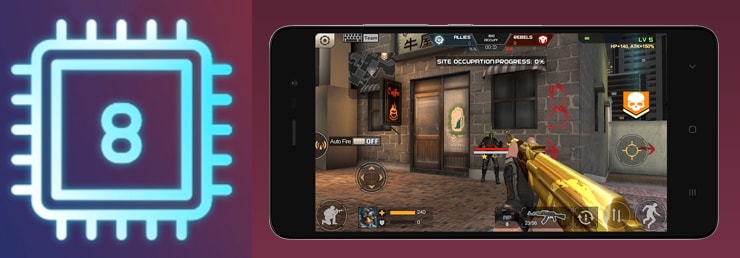Processor is like the brain of a smartphone. Almost everything you do on your smartphone, more or less depends on it. Naturally then, the thumb rule is to pick the best of what’s available. However, getting a high-end processor, means investing in an expensive flagship smartphone. You’ll definitely get the performance you’re paying for, but it’s important to ask yourself if you really need it. The amount of processing power you need depends on the tasks and applications you’d run on the phone. It is important to pick a smartphone with a processor that offers just the right amount of power, while still fitting comfortably in your budget. Picking a smartphone solely going by the processor is difficult for most people. There are so many jargons and technical terms to follow, which makes it a little complicated. So to help, here is a quick guide on understanding processors and picking a smartphone with the right one.
What is a processor?
Let’s start with getting a basic understanding of smartphone processors. For starters, they also go by the terms SoC (system-on-chip) and chipsets. A processor is directly responsible for the performance of your smartphone. The experience of anything you do on the phone, starting from opening apps, browsing the internet, playing movies or games, all depends on it. The better the processor, smoother and lag-free the experience with these tasks.

It’s not just down to crunching numbers as well. A processor also carries modules that support different hardware and features of the smartphone. This includes the camera, Wi-Fi, screen, security, graphics, Bluetooth, network connectivity and many others. A high-end processor then will support and offer the latest of features available with each of these components.
Choosing a processors based on specs – Cores and clock speed
A processor performance mostly depends on two specifications; the number of cores and the clock speeds it has to offer. Let’s explore how to go about choosing one based on these two numbers.
A core is an element of the processor that implements and executes tasks. Smartphones today, come with multiple cores. Each core is designed to handle and execute tasks. More the number of cores, more and heavier apps it can perform simultaneously. The current generations of smartphones come in a range of multi-core processors. Most commonly found are dual-core (two), quad-core (four) and octa-core (eight), with the latter being the most powerful. Some processors also come with hexa-core (six), but they are pretty rare.

Processors are also defined by their clock speeds, which is mentioned in Gigahertz (GHz). This often refers to the speeds at which each of the cores can perform tasks. Naturally, higher the number, better the performance. However, you might find multiple GHz numbers for multi-core processors, even on some high-end variants. That’s because most manufacturers try to create a balance between power and efficiency. For example, Qualcomm’s new Snapdragon 845 chipset features eight cores, four of which are clocked at 2.8GHz to deliver peak performance, and four are clocked at 1.7GHz, for delivering efficiency and consuming less battery.
So when picking a processor, make sure you not only look at the number of cores, but also compare clock speeds to get a better idea.
Choosing a processor based on the brand and series
Even with all the information above, picking a processor can be difficult. After all, it’s not easy to quantify your usage and compare it with the number of cores and core speeds (GHz), communicated by the company. If that’s too confusing for you, then you can simply go about choosing a processor based on brands and the series of chipsets defined by them.
There are only a handful of companies that make smartphone processors, out of which there are two who you really need to focus on; Qualcomm and MediaTek. Other companies like Apple, Samsung and Huawei also make processors, but they are generally used in their own devices. Qualcomm is more popular, mostly because their processors are often used by popular OEMs like Samsung, LG, HTC and Motorola. MediaTek on the other hand has a higher presence with upcoming brands like, Vivo, Oppo, Intex and Honor. You might still find them on some of the other manufacturers though.

One of the most common misconception is that Qualcomm processors are better, mostly based on benchmark scores. However when it comes to real-world scenarios, Mediatek processors can be equally good, especially in the budget segments. They focus on offering high-end features at much lower prices. Something that also reflects in the brands that use them.
Both companies have a range of chipsets setup across classes. Qualcomm has Snapdragon 200, 400, 600 and 800, with performance also based in that order. Each series carries a number of variants that have been launched over the last few years. The bigger the number, more recent and powerful the performance in that series. Qualcomm recently launched Snapdragon 845, which is their flagship processor and the highest performing yet. Most of the high-end devices you’d see this year are most likely going to feature this SoC.
MediaTek’s approach for identifying their processors is different. Their entry and mid-level variants are generally coined with ‘MT67’, followed by a two digit number. The higher that number the better the processor is in its given series. Moving up the ladder, MediaTek’s premium mid-range offerings are called Helio P, while their high-end ones go by Helio X. There are different variants in each of these segments. The one with the largest model number is the most powerful.
Of course, a good processor is not the only reason to get a smartphone, but it always helps to be able to determine which one you need. It helps clear out all the clutter and make an informed decision. Above that you also know what you’re actually paying for.



